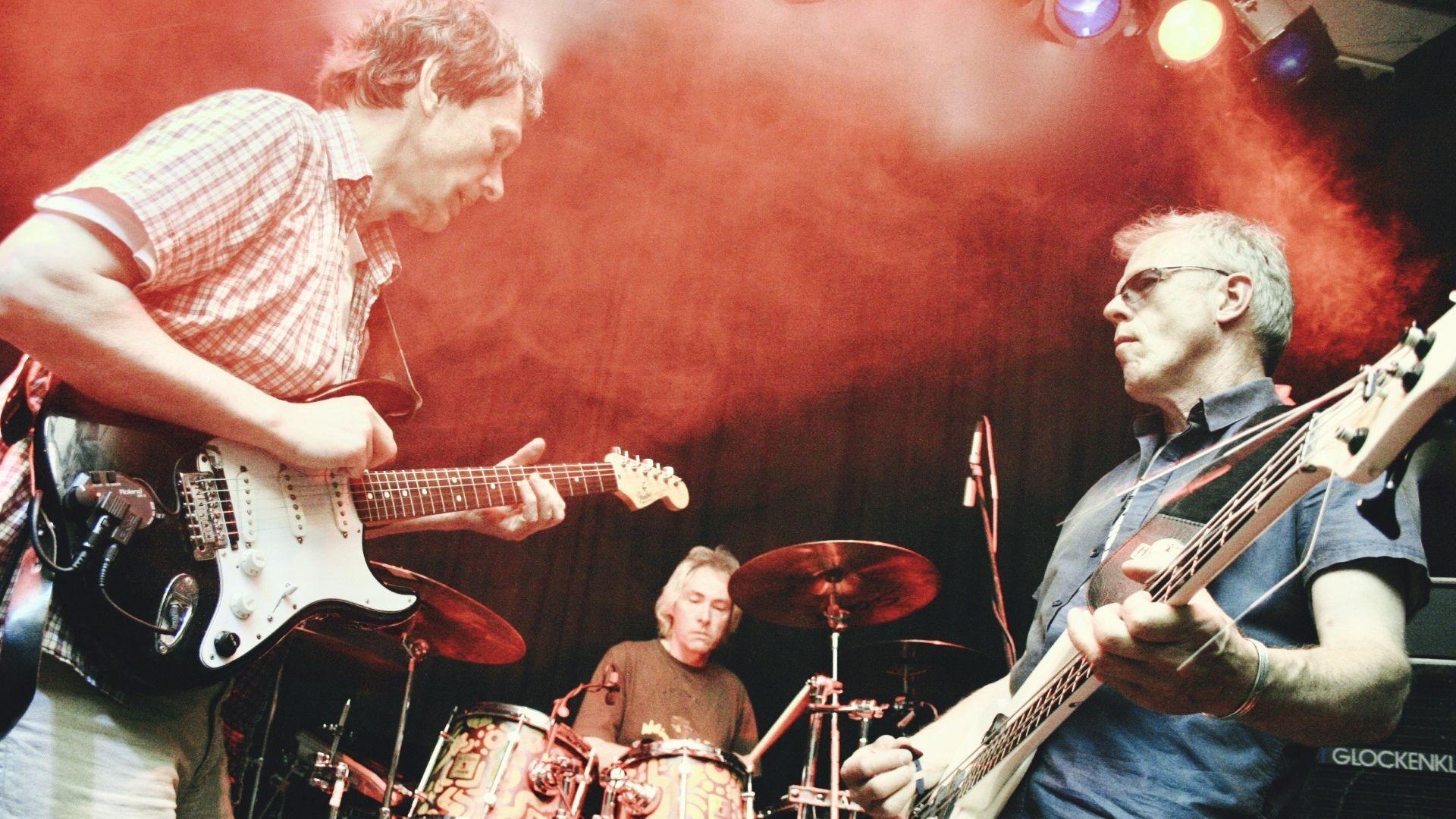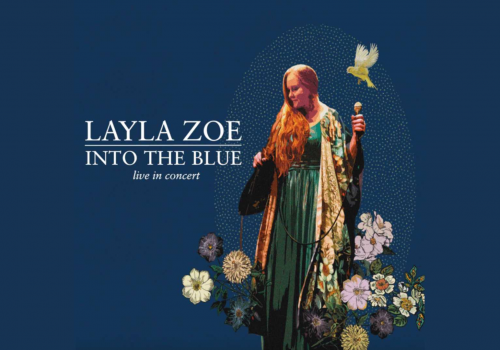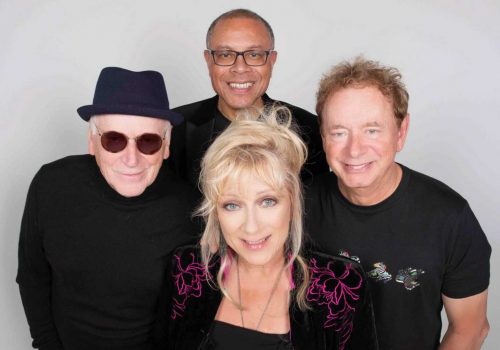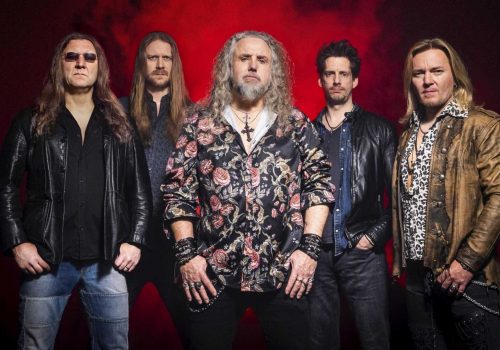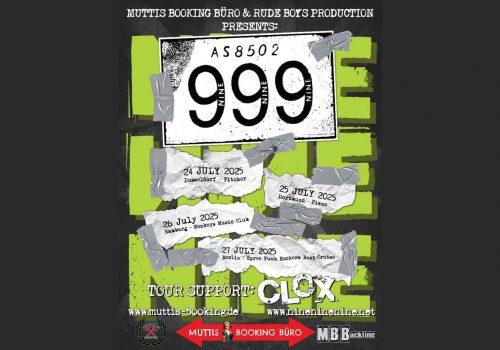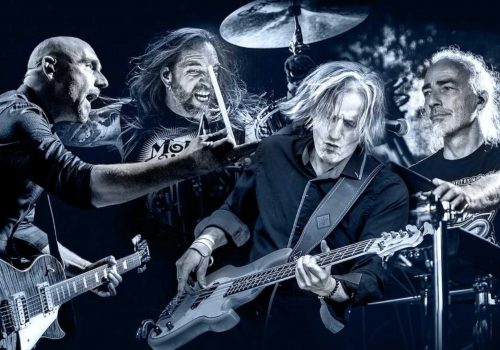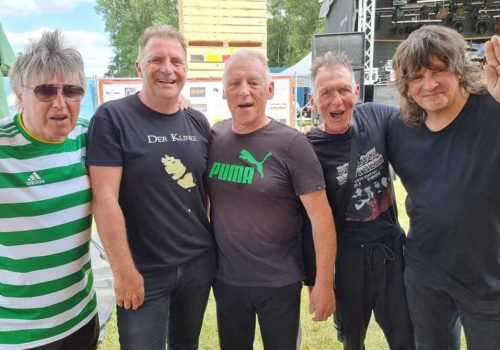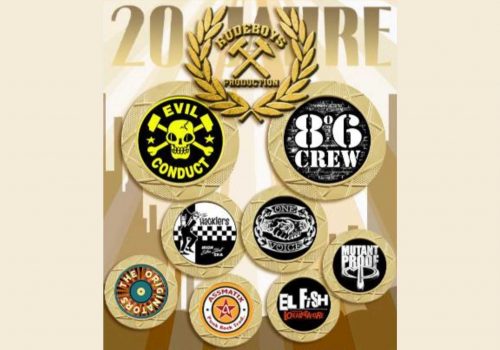Kraan
start page >> concerts >>
KRAAN
Tour 2026
What would the history of German rock music be without Kraan? Undoubtedly not only incomplete, but above all poorer by a particularly colorful, highly creative chapter.
From the beginning of their career, Kraan dedicated themselves to an exciting fusion of rock, jazz and ethnic influences and later added US mainstream and soul elements to their sound. They called their style ‘Wintrup Musik’, named after their home in the Teutoburg Forest. A small inheritance in May 1970 was the initial spark for the band. The four original ‘Kraaniche’ Peter Wolbrandt, Jan Fride, Hellmut Hattler and Alto Pappert threw their money together and bought a sound system plus a band bus. They recorded their debut album in a 2-day (!) studio session and also cultivated a penchant for spontaneity. The figureheads of Kraan were bassist Hellmut Hattler and guitarist Peter Wolbrandt, who were also the band's two main songwriters.
Kraan enjoyed the life of a musical commune. A disused pasture estate, a half-timbered building built in 1871 with about 4,000 square meters of land, lonely on the edge of the Teutoburg Forest, was their home in the seventies. Count Metternich had made the former horse stud available to the musicians - free of charge and without conditions. They lived there with 13 like-minded people (four musicians, the manager, two roadies, three wives, three children and several cats and dogs). Hattler characterized the philosophy of living together at the time with the words: "There is a friendly anarchy here. We have deliberately made no plans as to who has to clean where and when, or who has dish duty. It's quite difficult, of course, because we have to rely on our own insight." After all, "If everything is right in the kitchen, the music will be fine, too."
Although confronted with such banalities in everyday life, the band developed into one of the most extraordinary German formations in the following years. Their third release ‘Andy Nogger’ (the album title was critical of consumer terror and a reference to the ice cream advertising slogan ‘Nogger Dir einen’) sold 120,000 copies. The album was released in Austria, Switzerland, Holland, Canada, Australia, England, Scandinavia and South Africa and was named record of the year by the German ‘Musikexpress’. Just four weeks after its release in America, the album was ranked at number 9 in the Billboard charts as the most played LP on all US stations. After three studio works, their double album ‘Kraan Live’ was recorded in October 1974 in Berlin's ‘Quartier Latin’, one of the outstanding jazz rock albums of the day, recorded and edited by legendary producer Conny Plank. After an acclaimed performance at the Roskilde Festival in Denmark in June 1975, Kraan replaced Alto Pappert, who had left the band, with pianist/organist Ingo Bischof. With the following, also great ‘Let It Out’ album, which was produced by Conny Plank in a mobile studio in Wintrup, quasi between horse stable and kitchen stove, Kraan advanced to group of the year in the magazine ‘Sounds’. ME' also liked the band: “Long collective improvisations between jazz, rock and blues are interrupted with playful ease for a few bars of arranged parts,” wrote the magazine in November 1975. “This shows real skill and the Kraan people realize their unusual musical ideas with so much empathy and precision, as if they wanted to wink at the genius of Frank Zappa.”
After 'Let It Out` a new era began for Kraan. The two following albums 'Wiederhören' (1977) and 'Flyday' (1978), but especially the '83 opus 'Nachtfahrt' (in between the release of the second live album 'Tournee'), reflected the changed zeitgeist. The New German Wave entered the German music landscape. Kraan were not uninfluenced by it. And vice versa. Hattler: "Many of these bands were Kraan fans, and were impressed by what we did on 'Flyday`, especially Peter`s arpeggio guitar style, and let these elements flow into their music as well. 'Nachtfahrt`, on the other hand, was a more or less ironic take on the music scene at the time on our part." Both releases, however, were only partly genuine Kraan records, but rather - as Hattler puts it - "half solo works by Peter and half by me." At that time Kraan no longer existed as a creative and producing band as in Wintrup's time; the group's activities were limited to touring in changing lineups until 1984. After that it was supposed to be finally over, but already in 1988 the third stage work 'Live '88' was released, followed by the last two studio albums 'Dancing In The Shade' and 'Soul Of Stone'.
With a performance in 1992 at the 'Dokumenta` in Kassel the Kraan history closed for the almost complete decade of the 90s.
Hattler continued his career with trumpeter Joo Kraus, who could already be heard on the last Kraan releases, in the formation Tab Two, Wolbrandt devoted himself to his learned profession as a graphic artist and programmer, and it was only on the occasion of Kraan`s thirtieth anniversary that the band reformed in the spring of 2000 with Hattler in the line-up, Wolbrandt, Bischof and Fride, released the two anniversary concerts ('Live2001'), played an extremely successful German tour and released their comeback album 'Through' at the end of June 2003, which miraculously seamlessly continues the old virtues without sounding dusty or outdated by the zeitgeist. Also on the follow-up Psychedelic Man (for which EMI has reanimated their legendary "Harvest" label), this distinctive band proves to be a cornucopia of creativity and musicality, which is unique in this form in Germany.
Since the beginning of 2008, the desire that had long been in the air was realized to play live again more freely and more in line with the abilities of the original members. Since then KRAAN consists "only" of the three founding members Peter Wolbrandt, Hellmut Hattler and Jan Fride Wolbrandt, completed celebrated tours and released in 2011 in this line-up their current album with the title "Diamonds", which sounds highly modern and yet 100% like KRAAN and thus clearly shows that this band seems to be subject to any time scheme; after all, no predicate is used in connection with KRAAN as often as the word "timeless".
So in 2008 KRAAN slimmed down to a classic core trio without ever sounding like one. The three school friends Peter and Jan Fride Wolbrandt as well as Hellmut Hattler did not become stewards of their own heritage, but wrote new pieces, produced fresh albums, interpreted their own classics virtuously, funky and with an extreme amount of drive. Again and again they proved that they are simply unbeatable in their very own Kraan terrain between rock and jazz. With "The Trio Years" and "The Trio Years - Encore!" the best - so to speak - and beyond that the complete repertoire of the past live years can be heard, and that's not all: At the end of 2020 (after ten years) also a new studio album was released again with the title "Sandglass".
The story seems to continue unabated even after more than 50 years (1971-2021)...
Details
Date:
Start:
Admission:
Price:
Details
Date:
Start:
Admission:
Price:
KRAAN
Tour 2026
What would the history of German rock music be without Kraan? Undoubtedly not only incomplete, but above all poorer by a particularly colorful, highly creative chapter.
From the beginning of their career, Kraan dedicated themselves to an exciting fusion of rock, jazz and ethnic influences and later added US mainstream and soul elements to their sound. They called their style ‘Wintrup Musik’, named after their home in the Teutoburg Forest. A small inheritance in May 1970 was the initial spark for the band. The four original ‘Kraaniche’ Peter Wolbrandt, Jan Fride, Hellmut Hattler and Alto Pappert threw their money together and bought a sound system plus a band bus. They recorded their debut album in a 2-day (!) studio session and also cultivated a penchant for spontaneity. The figureheads of Kraan were bassist Hellmut Hattler and guitarist Peter Wolbrandt, who were also the band's two main songwriters.
Kraan enjoyed the life of a musical commune. A disused pasture estate, a half-timbered building built in 1871 with about 4,000 square meters of land, lonely on the edge of the Teutoburg Forest, was their home in the seventies. Count Metternich had made the former horse stud available to the musicians - free of charge and without conditions. They lived there with 13 like-minded people (four musicians, the manager, two roadies, three wives, three children and several cats and dogs). Hattler characterized the philosophy of living together at the time with the words: "There is a friendly anarchy here. We have deliberately made no plans as to who has to clean where and when, or who has dish duty. It's quite difficult, of course, because we have to rely on our own insight." After all, "If everything is right in the kitchen, the music will be fine, too."
Although confronted with such banalities in everyday life, the band developed into one of the most extraordinary German formations in the following years. Their third release ‘Andy Nogger’ (the album title was critical of consumer terror and a reference to the ice cream advertising slogan ‘Nogger Dir einen’) sold 120,000 copies. The album was released in Austria, Switzerland, Holland, Canada, Australia, England, Scandinavia and South Africa and was named record of the year by the German ‘Musikexpress’. Just four weeks after its release in America, the album was ranked at number 9 in the Billboard charts as the most played LP on all US stations. After three studio works, their double album ‘Kraan Live’ was recorded in October 1974 in Berlin's ‘Quartier Latin’, one of the outstanding jazz rock albums of the day, recorded and edited by legendary producer Conny Plank. After an acclaimed performance at the Roskilde Festival in Denmark in June 1975, Kraan replaced Alto Pappert, who had left the band, with pianist/organist Ingo Bischof. With the following, also great ‘Let It Out’ album, which was produced by Conny Plank in a mobile studio in Wintrup, quasi between horse stable and kitchen stove, Kraan advanced to group of the year in the magazine ‘Sounds’. ME' also liked the band: “Long collective improvisations between jazz, rock and blues are interrupted with playful ease for a few bars of arranged parts,” wrote the magazine in November 1975. “This shows real skill and the Kraan people realize their unusual musical ideas with so much empathy and precision, as if they wanted to wink at the genius of Frank Zappa.”
After 'Let It Out` a new era began for Kraan. The two following albums 'Wiederhören' (1977) and 'Flyday' (1978), but especially the '83 opus 'Nachtfahrt' (in between the release of the second live album 'Tournee'), reflected the changed zeitgeist. The New German Wave entered the German music landscape. Kraan were not uninfluenced by it. And vice versa. Hattler: "Many of these bands were Kraan fans, and were impressed by what we did on 'Flyday`, especially Peter`s arpeggio guitar style, and let these elements flow into their music as well. 'Nachtfahrt`, on the other hand, was a more or less ironic take on the music scene at the time on our part." Both releases, however, were only partly genuine Kraan records, but rather - as Hattler puts it - "half solo works by Peter and half by me." At that time Kraan no longer existed as a creative and producing band as in Wintrup's time; the group's activities were limited to touring in changing lineups until 1984. After that it was supposed to be finally over, but already in 1988 the third stage work 'Live '88' was released, followed by the last two studio albums 'Dancing In The Shade' and 'Soul Of Stone'.
With a performance in 1992 at the 'Dokumenta` in Kassel the Kraan history closed for the almost complete decade of the 90s.
Hattler continued his career with trumpeter Joo Kraus, who could already be heard on the last Kraan releases, in the formation Tab Two, Wolbrandt devoted himself to his learned profession as a graphic artist and programmer, and it was only on the occasion of Kraan`s thirtieth anniversary that the band reformed in the spring of 2000 with Hattler in the line-up, Wolbrandt, Bischof and Fride, released the two anniversary concerts ('Live2001'), played an extremely successful German tour and released their comeback album 'Through' at the end of June 2003, which miraculously seamlessly continues the old virtues without sounding dusty or outdated by the zeitgeist. Also on the follow-up Psychedelic Man (for which EMI has reanimated their legendary "Harvest" label), this distinctive band proves to be a cornucopia of creativity and musicality, which is unique in this form in Germany.
Since the beginning of 2008, the desire that had long been in the air was realized to play live again more freely and more in line with the abilities of the original members. Since then KRAAN consists "only" of the three founding members Peter Wolbrandt, Hellmut Hattler and Jan Fride Wolbrandt, completed celebrated tours and released in 2011 in this line-up their current album with the title "Diamonds", which sounds highly modern and yet 100% like KRAAN and thus clearly shows that this band seems to be subject to any time scheme; after all, no predicate is used in connection with KRAAN as often as the word "timeless".
So in 2008 KRAAN slimmed down to a classic core trio without ever sounding like one. The three school friends Peter and Jan Fride Wolbrandt as well as Hellmut Hattler did not become stewards of their own heritage, but wrote new pieces, produced fresh albums, interpreted their own classics virtuously, funky and with an extreme amount of drive. Again and again they proved that they are simply unbeatable in their very own Kraan terrain between rock and jazz. With "The Trio Years" and "The Trio Years - Encore!" the best - so to speak - and beyond that the complete repertoire of the past live years can be heard, and that's not all: At the end of 2020 (after ten years) also a new studio album was released again with the title "Sandglass".
The story seems to continue unabated even after more than 50 years (1971-2021)...

